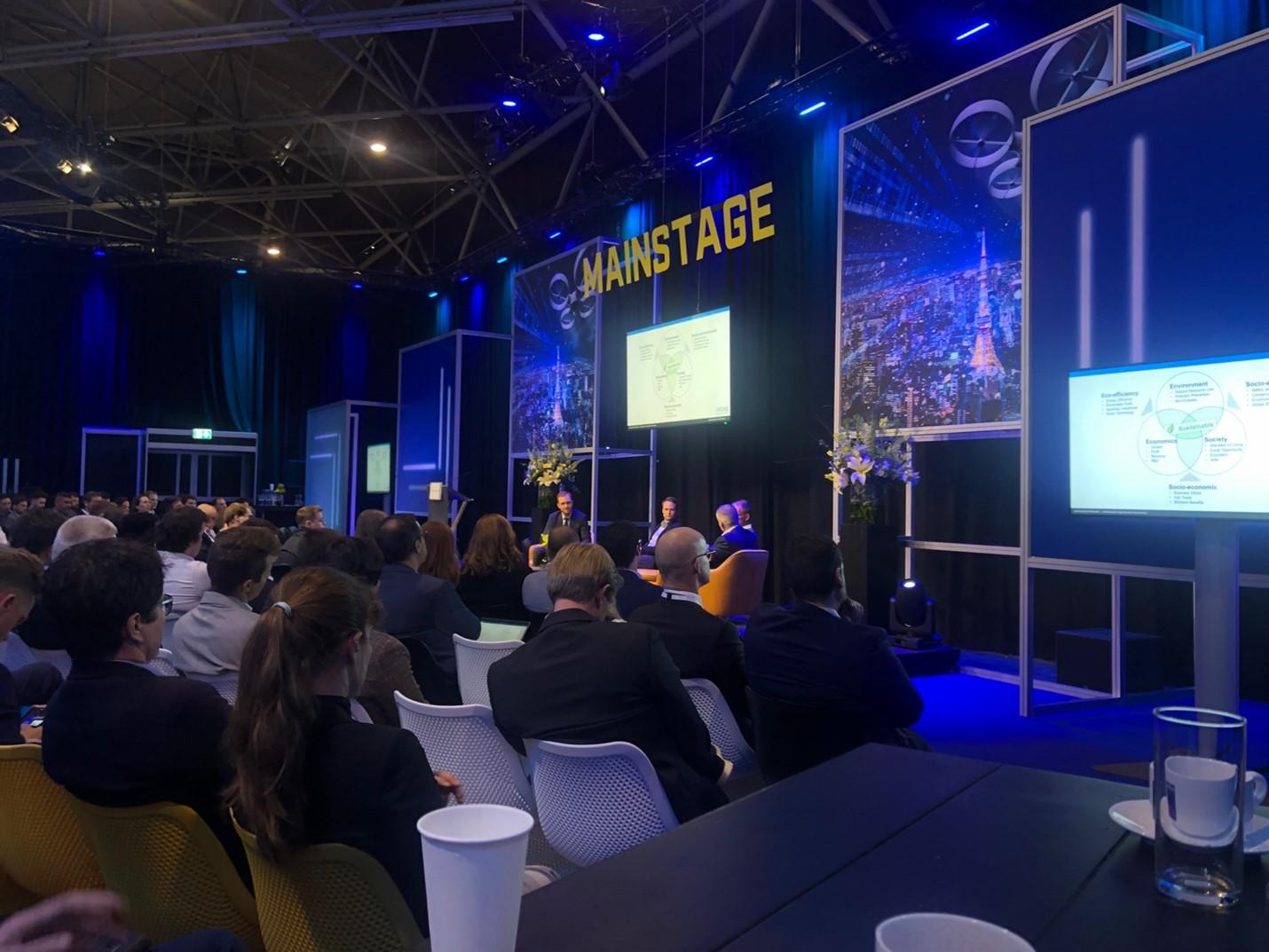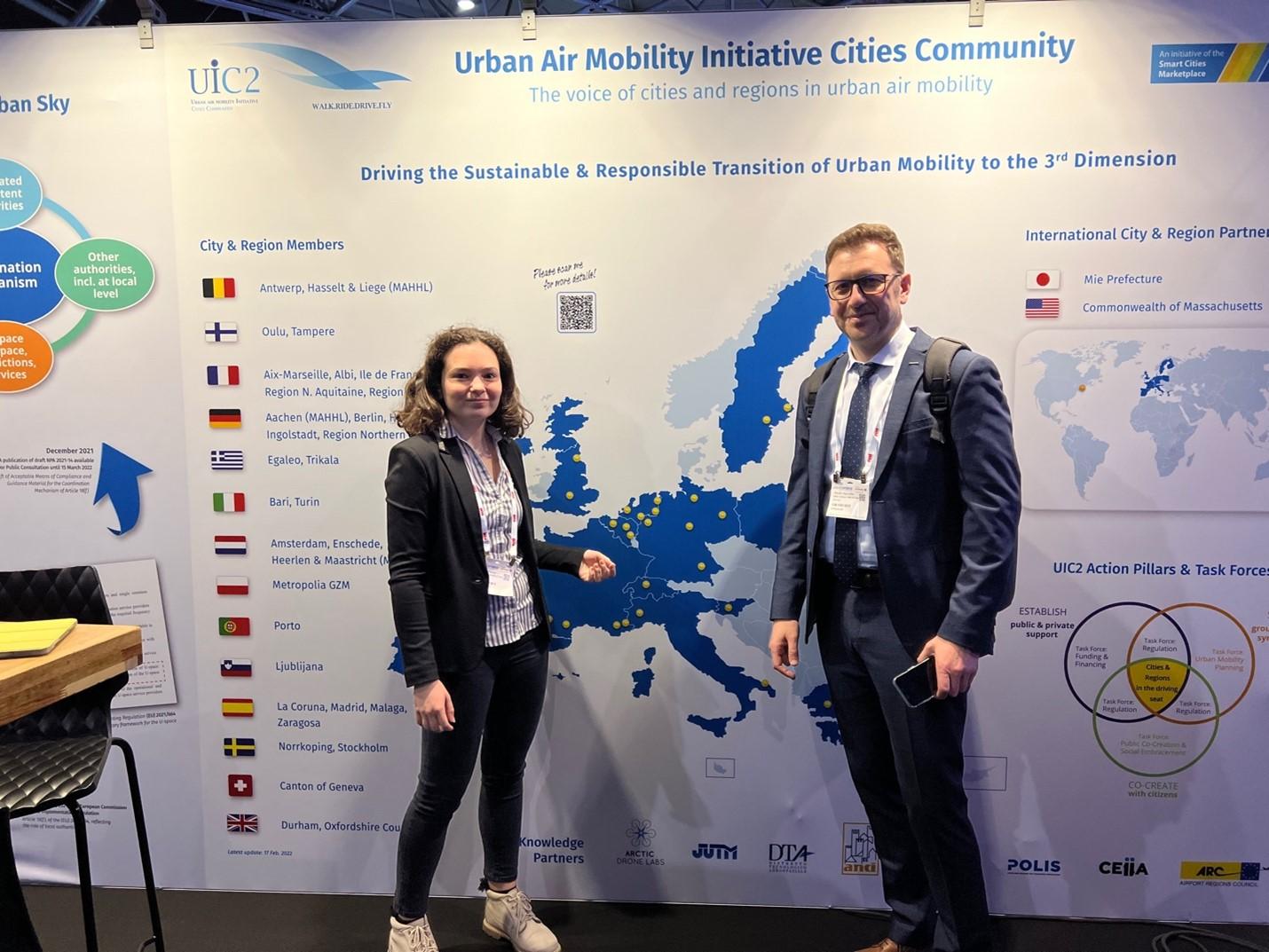In this blog Vera Safronova, master's student Urban Management and Development and Junior Researcher at the Centre for BOLD Cities, shares her experiences of visiting the Amsterdam Drone Week 2022.
Amsterdam Drone Week
Urban Air Mobility (UAM) is a novel air transportation system for cargo and passengers. In line with BOLD Cities work on UAM, I was given an exciting opportunity to visit Amsterdam Drone Week (ADW) 2022. The conference serves as a meeting space for many important stakeholders in the UAM community ranging from regulators (the European Commission and European Union Aviation Safety Agency (EASA)) to industry players such as Airbus, Volocopter, and Manna Drone Delivery to organised initiatives like UAM Initiative Cities Community (UIC2). This year’s focus areas were social acceptance of UAM and adding value to society with this emerging transportation system. In line with that, Patrick Ky, Executive Director of EASA, in the opening speech stated that public acceptance is key to the further development of UAM. Many speakers reiterated this message during many other sessions that I have attended.

Due to the underlying complexity of UAM, participants cannot seem to agree on a single vision about what exactly the future of aviation will be. For example, there is no agreement on the best application of vertical take-off and landing (VTOL) aircrafts. Some industry representatives aim solely to design aircrafts for passenger transportation (Lilium). Others claim that medical deliveries bare the most potential to be brought to life. Another gap that impedes the implementation of UAM is the deadlock between regulators and manufacturers. Manufacturers rely on the technical regulations from the governments to design and operate their aircrafts. On the other hand, regulators do not have a reference point to create such rules as they have never faced such complex technological developments before, are uncertain about the integration of unmanned aviation with manned aviation, and are held accountable by residents to uphold the safety of the VTOLs. Currently, the UAM operations are permitted on a case-by-case basis outside vast no-fly zones and are far from full-fledged regular flights. During ADW, these constituted a wider concern that regulators do not know what to expect from the manufacturers and vice versa. Hence, a louder call at the conference was for synergies between all actors rather than social acceptance.

The backbone of ADW consisted of technical topics about UAM, such as integration of electric VTOLs (eVTOLs) in the current aviation system, their certification, and design and development of ground infrastructure such as vertiports. Interestingly, this pattern of the predominance of the technical and technological aspects of UAM is evident in the academic field as well. During research for the LDE Centre for BOLD Cities, I have looked through 22,532 publications in Scopus’ database containing the search term drones published between 2006 and 2021. The documents were coded to belong to a specific field of science based on their titles, abstracts, and the source. The code to which most of the papers were attributed is formal science and engineering. This indicates that drone research is predominantly preoccupied with the scientific aspect of this new technology.
Questions of integration of drones into the lives of people and assessing public attitudes to UAVs coded as social UAM are largely unattended as this category contains the lowest number of documents. This trend is reflected in the Conference as I have met only one speaker, Dominique Lazarski, the President of the European Union against Aircraft Nuisance (UECNA) that represents the people who live on the regular routes of aircrafts, suffering from noise and other emissions. Otherwise, it was common, especially for industry professionals, to refer to residents merely as a consumer, thus, not taking into account the experiences and perceptions of non-users who also have a say in the UAM operations happening overhead and resulting in changing patterns of socio-spatial justice and spatial planning of the areas where they live.
When it came to sessions and discussions on social acceptance, the guiding argument was that if public concerns are addressed by the VTOL’ manufacturers and ensured by the regulators, then the public will “accept” and use UAM. The discussion of recognised public concerns closely followed EASA’s “Study on the societal acceptance of Urban Air Mobility in Europe” and included safety, privacy, noise, and impact on wildlife. However, when the debate is framed only in terms of public acceptance instead of broader public engagement, the public is not keen on using UAM. I have asked the conference participants what they think of UAM as citizens and potential users. The general response was similar to the EASA study: Residents welcome medical deliveries and rescue operations but are more pessimistic on passenger transportation and goods delivery use-cases. Dominique Lazarski, for instance, explained that air taxis are not what people need because they would pollute the surroundings in many other ways than just noise. Some, like George Zogopoulos, a Controls Engineer at Avy, explained that the eVTOLs will gain more acceptance overtime as people become more accustomed to the idea.
So far, with just addressing safety, noise, and privacy concerns in the eVTOL operations, the UAM becomes a grim future for aviation. However, some sessions and speakers highlighted a need for wider integration of society into the UAM project in order to make it more citizen-centric. Speakers from the European Commission proclaimed that a crucial part of social acceptance is educating people on why drones are good through demonstrations of specific use cases with locals. This attitude of the EU is reflected in the UIC2. Its sessions and recent publication, “Urban Air Mobility and Sustainable Urban Mobility Planning – Practitioner Briefing”, position citizens in the centre of UAM and call for engaging the public at every stage of the UAM development. An example of such approach can be found in Górnośląsko-Zagłębiowska Metropolia (GZM) of Poland, where UAM is being implemented in a cooperative nature: The local governments are approached by GZM, educating them on UAM and possible use cases specific to the municipality before introducing drones. UIC2 and its member-cities presented a wider view on the citizen acceptance during the conference by not merely viewing it as satisfying their concerns but working towards a contestable UAM, one where the public can interact openly with other stakeholders and affect the decision-making process.

Overall, ADW was an enlightening experience that highlighted various views on UAM and its implementation. It was a great opportunity to interact with experts from different fields and find common ground with them. The conference also gave a strong push to my upcoming research at LDE Centre BOLD Cities, as this debate about the role and operationalisation of citizen acceptance and engagement inspired a range of questions that are soon to be investigated. So stay tuned!
